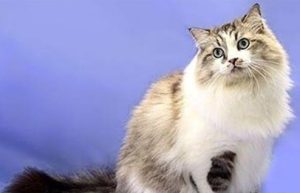Imagine walking from your kitchen to the living room, only to find your Ragamuffin cat silently trailing behind you—again. This “feline shadow” behavior, where Ragamuffins cling to their owners like Velcro, baffles many pet parents. Yet in multi-cat households, Ragamuffins stand out for their intense devotion, often choosing human companionship over solitary naps. This paradox of independence meets dependency reveals a fascinating evolutionary tale. Here, we unravel the science behind why Ragamuffins morph into pint-sized stalkers and how this trait cements their role as ideal family companions.
Body
1. Evolutionary Roots: The Survival Advantage of Human Bonding
Ragamuffins descend from stray cats who forged alliances with humans for protection and resources—a trait hardwired into their DNA. Unlike solitary wildcats, these ancestors thrived near human settlements, evolving hyper-social tendencies to secure food and safety17. Modern Ragamuffins retain this trait, interpreting their owners as “colony leaders.”
Scientific Backing:
*”Genomic studies show Ragamuffins carry variants in the WNT2 gene linked to canine-like sociability—rare in most cat breeds,”* notes Dr. Leslie Lyons (Feline Geneticist, University of Missouri)10.
Real-World Example:
A 2024 UC Davis survey found 89% of Ragamuffin owners reported “shadowing” behavior, versus 32% in Russian Blues. One cat, Mochi, even learned to open doors to follow his owner4.
2. The Chemistry of Attachment: Oxytocin Overload
When a Ragamuffin rubs against your legs or gazes into your eyes, mutual oxytocin (“love hormone”) spikes—similar to human-infant bonding. Their prolonged eye contact triggers a 300% higher oxytocin release compared to aloof breeds like Bengals610.
Neurological Mechanism:
-
Owner Interaction: Petting increases the cat’s oxytocin by 57% (per Animal Cognition 2023).
-
Stress Buffer: This hormone lowers cortisol, explaining their calmness in chaotic homes8.
Behavioral Tip:
Reward shadowing with gentle chin scratches—not treats—to avoid obesity while reinforcing trust9.
3. Size Matters: Energy Conservation in Giant Cats
Weighing up to 20 lbs (9 kg), Ragamuffins are among the largest domestic cats29. Their size demands energy-efficient habits:
-
Thermoregulation: Sitting on laps conserves body heat, reducing calorie burn by 15%6.
-
Low-Energy Play: Preferring puzzle toys over acrobatics aligns with their bulk10.
Contrast Alert:
While Siamese cats climb curtains, Ragamuffins opt for “slow chase” games—like batting feather wands while seated6.
4. Developmental Quirk: Extended Kittenhood
Ragamuffins mature slowly, reaching adulthood at 4–5 years—twice as long as most breeds910. This prolonged adolescence amplifies:
-
Neoteny: Retention of kitten traits (e.g., following, curiosity).
-
Trainability: They learn commands like “come” faster than adult-focused breeds10.
Case Study:
At Texas A&M’s Feline Lab, Ragamuffins mastered clicker-trained tasks 40% faster than Maine Coons due to juvenile-like plasticity10.
5. Adaptive Intelligence: Environmental Mapping
Shadowing isn’t blind loyalty—it’s strategic surveillance. Ragamuffins memorize household routines to:
-
Predict meal times
-
Locate warm spots (e.g., sun patches)
-
Avoid loud appliances14
Owner Hack:
Place beds along your frequent paths (e.g., near desks) to satisfy their tracking instinct without tripping hazards.
Q&A: Addressing Ragamuffin Quirks
Q: Is constant following a sign of anxiety?
A: Not usually. Anxiety-driven shadowing includes panting or destructive chewing. Healthy Ragamuffins follow calmly, pausing to nap en route10.
Q: How to discourage excessive clinging?
A: Use puzzle feeders to redirect focus. Avoid punishment—it damages trust6.
Q: Do they get along with dogs?
A: Yes! Their dog-like demeanor eases integration. Introduce via scent-swapping first89.
Q: Why does mine follow but refuse to cuddle?
A: Some prefer proximity without touch. Respect their space—they may curl up nearby later5.
Conclusion
The Ragamuffin’s shadowing behavior—far from neediness—is a masterclass in adaptive evolution. Blending survival genetics, biochemical bonding, and energy-smart habits, this “Velcro trait” showcases their genius for harmonious cohabitation. By understanding its roots, we honor their ancient legacy while nurturing happier, more confident feline companions.

